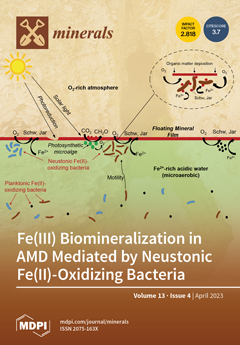The magmatic process within upper crust encompasses various contents such as the transition between magmatic and hydrothermal systems and changes in oxygen fugacity (ƒO
2), which ultimately play key roles in the formation of porphyry Cu deposits (PCDs). However, tracing these magmatic
[...] Read more.
The magmatic process within upper crust encompasses various contents such as the transition between magmatic and hydrothermal systems and changes in oxygen fugacity (ƒO
2), which ultimately play key roles in the formation of porphyry Cu deposits (PCDs). However, tracing these magmatic processes, especially in porphyry systems, is not an easy task. This study reported the detailed process of magmatic fluid exsolution and systematical variation of magmatic ƒO
2 within the upper crust of a Tongchang–Chang’anchong porphyry Cu deposit, based on detailed investigations of mineral crystallization sequences and compositional features of the minerals in the fertile porphyries. Results indicate that the fertile porphyries show a high initial ƒO
2, with ΔFMQ ≥ +3.0 (ΔFMQ is the deviation of logƒO
2 from the fayalite–magnetite–quartz (FMQ) buffer). The magmatic ƒO
2 (ΔFMQ) continued to decrease to ~+2 until fluid exsolution occurred at ~790 °C due to wall-rock contamination. The magmatic fluid exsolution process caused a temporary increase in the ƒO
2 (to ΔFMQ = ~+3.4). The high magmatic ƒO
2 during this process (790–750 °C) resulted in a higher content of ore-forming materials in the exsolved magmatic fluid. When the temperature dropped below 750 °C, the magmatic ƒO
2 began to continuously decrease and eventually reached ΔFMQ = ~+0.6. The lower magmatic ƒO
2 hindered the further migration of ore-forming materials through the exsolved fluid during this process (< 750 °C). Results of this study indicate that the initial magma during the upper crustal magmatic process of PCDs generally has a high ƒO
2, and the contamination of reduced components can significantly decrease the magmatic ƒO
2. The early magmatic fluid exsolution process can maintain a high magmatic ƒO
2 condition, thereby efficiently extracting ore-forming minerals and producing ore-forming fluids, which is the key to the formation of PCDs. The latter continuous decrease in magmatic ƒO
2 during the fluid exsolution process may be the reason preventing the Tongchang–Chang’anchong porphyry Cu deposit to form a giant PCD.
Full article





